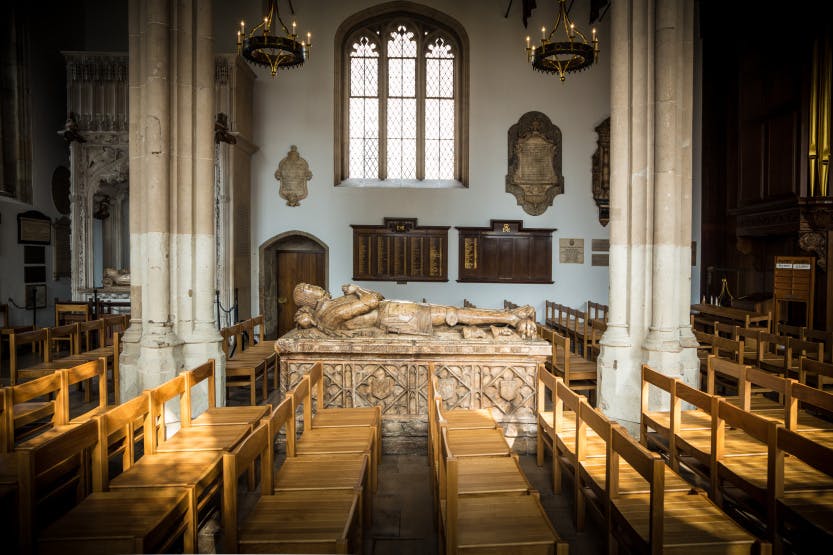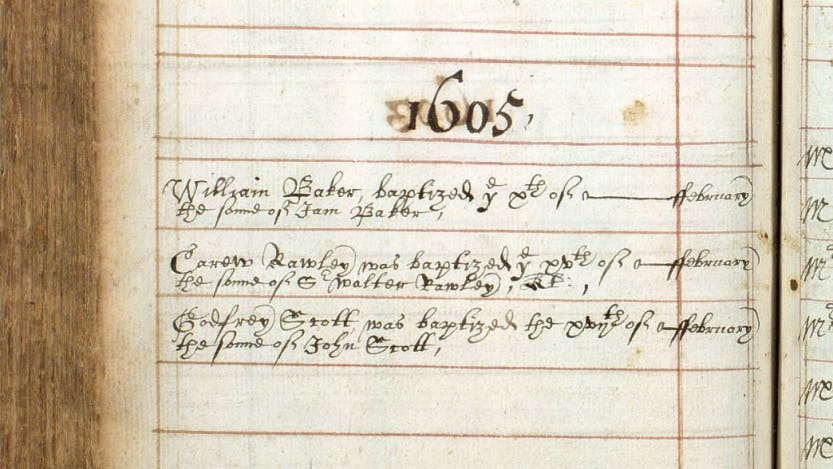500 years of the Chapel Royal of St Peter ad Vincula
Date: 19 September 2020
2020 happily marks the 500th anniversary of the Tower of London's Chapel Royal of St Peter ad Vincula! There's no better time to dive into the Chapel's five centuries of fascinating history. An active parish church at the centre of the Tower community to this day, St Peter ad Vincula has also witnessed some of the darkest chapters of the Tower's history, and today is the final resting place of three queens of England.
Assistant Curator of Historic Buildings Alfred Hawkins introduces some of the extraordinary stories surrounding this little Tudor church at the heart of our fortress.

The First Chapel
500 years is a grand age to reach by any measure, but the origins of the Chapel of St Peter ad Vincula at the Tower of London actually pre-date the 11th-century White Tower, and are likely related to a 9th-century Saxon chapel. This was demolished so that, in 1128, Henry I could build a new chapel located outside the walls of the Tower. During the reign of Edward I 'Longshanks', the Tower of London was expanded into a concentric castle. This large scheme of works required that Henry I's chapel be demolished and a 'great new Chapel' built within the walls of the formidable fortress in 1286-7. Edward I's chapel stood for 225 years until it was lost in a catastrophic fire in 1512.
Following this conflagration, the Chapel was rebuilt between 1519 and 1520 by Sir Richard Cholmondeley, Lieutenant of the Tower, whose tomb occupies the centre of the nave. It is this building which stands in the shadow of the White Tower today. This survival is remarkable in itself as much of the fabric, including its decorative arches, and some of the windows, are original. The Chapel's Spanish chestnut roof is particularly important: it was constructed so Queen Katherine of Aragon, Henry VIII's wife, might find God beneath the trees of her homeland. At first, Saint Peter's was used as a Catholic chapel. Evidence of this can still be seen today: the Piscina (a stone basin for washing holy items) and hagioscope (or 'squint', a little eye-level window for glimpsing the altar) on the eastern wall are only found in Catholic or Pre-Reformation churches and chapels.
Now, we can't always fully escape the brutality of the past as, following Henry VIII's split from Rome, both Thomas More, Henry VIII's Lord Chancellor, and John Fisher, the Bishop of Rochester, were executed in 1535 and are buried here. Both are revered as saints of the Catholic Church and are remembered through a dedicated place of worship in the crypt. Most famous however, is the burial of three Queens of England within the Chapel: Anne Boleyn, Catherine Howard and Lady Jane Grey, who were all beheaded at the Tower.
Marriages, Baptisms and Burials
These stories of treachery and treason often capture our imagination, but it is important to remember that Saint Peter ad Vincula has been a place of joy in equal measure to tragedy. Its primary role has always been to care for the spiritual needs of the Tower community, and the number of marriages and baptisms within the chapel far outweigh the number of burials.
This care was also extended to those individuals imprisoned within the fortress. The Chapel's Register for Marriages, Baptisms and Burials starts in 1550 and documents many of these more personal moments. A particularly interesting entry is that of the baptism of Sir Walter Raleigh's son Carew in 1605, who was conceived during Raleigh's long imprisonment in the Bloody Tower. It reads: "Carew Rawley, was baptized ye 15th February / the sonne of S[ir] Walter Rawley, [Knight]."
Restoring the Chapel
In 1841, the chapel was again the victim of a disastrous fire which tore through the Grand Storehouse, located next door where the Waterloo Block now stands. The chapel's roof was damaged and, having been vandalised by a number of poorly judged alterations since the Tudor period, Queen Victoria, who had been on the throne for only four years, supported proposals to restore the building to its former splendour. It was in this period that the interior of the chapel as we know it was formed.
While a number of alterations were made following the fire of 1841, the full restoration of the Chapel didn't occur until 1876, when the floor was excavated, revealing the remains of 1,768 individuals. The majority of these were 'ordinary' people who were all re-interred in the nearby crypt. This history was brought to light again in 2019 when, during archaeological investigations into the surrounding area, two complete skeletons were exhumed. The individuals, buried between 1450 and 1550, included a 35-45-year-old female and a 7-year-old child. These remains were the first within the Tower to be fully assessed by an osteologist and provide us with a remarkable insight into everyday life at the Tower. The remains were then reinterred in the Chapel at a special ceremony, to ensure the continued care of the remains.
The Chapel Today
As the chapel moved into the 20th century, it continued to evolve. The largest addition was the tomb of John Holland, Earl of Huntingdon, who was Constable of the Tower in the 15th century. Originally placed in the Chapel of the Royal Hospital of St Katherine-by-the-Tower, it was moved to a chapel at Regent's Park, before finding its final home in the Chapel of Saint Peter in 1951. In 2014, a full refurbishment of the Chapel was undertaken when all the furniture was replaced and much of the historic fabric was conserved. The Chapel was reopened by HM The Queen later that year.
Today, 500 years after its dedication and in the care of our resident Chaplain the Reverend Canon Roger Hall MBE, the Chapel continues its role as the spiritual heart of the Tower of London: a lasting legacy of 1200 years of Christian worship in the City of London.
Alfred Hawkins
Assistant Curator of Historic Buildings Tower of London
More from our blog

Secrets of Henry VIII's Whitehall: The Archaeology of a Lost Palace
17 August 2023
More than 300 years after the destruction of Whitehall Palace by fire, archaeological excavation and scientific analysis continue to uncover the lost stories and secrets of Henry VIII's once elaborate home.

A Short History of the Jewel House at the Tower of London
11 December 2023
Tom Drysdale, Archivist and Curator of Architectural Drawings at the Tower of London, explores the fascinating history of the world-famous Crown Jewels exhibition.

Caring for the Tower of London through lockdown
11 May 2021
While the Tower of London was closed to the public during the Covid-19 pandemic, much work was underway to protect the fabric of the building and the future of the palace. Assistant Curator Alfred Hawkins reveals one of the important projects that he has been working on behind the scenes.




